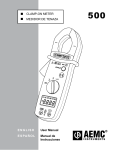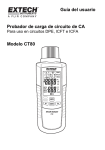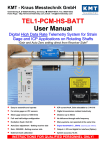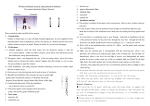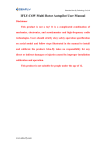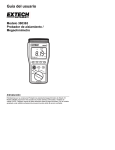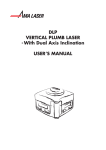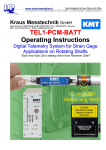Download Model 502 - Instrumart
Transcript
n TRMS CLAMP-ON METER n MEDIDORES DE TENAZA TRMS ENGLISH User Manual E S PA Ñ O L Manual de Instrucciones 502 Table of Contents ENGLISH ................................................................ 1 ESPAÑOL.............................................................. 21 1. 2. 3. 4. INTRODUCTION ............................... 3 1.1 International Electrical Symbols .......... 4 1.2 Receiving Your Shipment .................... 4 1.3 Ordering Information ........................... 4 PRODUCT FEATURES....................... 5 2.1 Control Features ................................. 5 2.2 LCD Display ........................................ 6 SPECIFICATIONS ............................. 7 3.1 Electrical Specifications ...................... 7 3.2 Mechanical Specifications................... 8 3.3 Environmental Specifications .............. 9 3.4 Safety Specifications .......................... 9 OPERATION .................................... 10 4.1 AC Current Measurement ................. 10 4.2 AC Volt Measurement ........................11 4.3 DC Volt Measurement ....................... 12 4.4 Resistance Measurement ................. 13 4.5 Continuity Measurement ................... 14 4.6 Frequency Measurement Using Current Input ..................................... 15 4.7 Frequency Measuring Using Voltage Input ..................................... 16 TRMS Clamp-on Meter Model 502 1 5. MAINTENANCE............................... 17 5.1 Warning............................................. 17 5.2 Cleaning ............................................ 17 5.3 Battery Replacement ........................ 18 Repair and Calibration....................................... 19 Technical and Sales Assistance ........................ 19 Limited Warranty ............................................... 20 Warranty Repairs............................................... 20 2 TRMS Clamp-on Meter Model 502 CHAPTER 1 INTRODUCTION Warning ● Read the user manual before operating and follow all safety information. ● Only use the meter as specified in this user manual. ● Never use this meter on a circuit with voltages greater than 600Vrms @ 50/60Hz. ● Never measure current while the test leads are connected to the input jacks. ● Do not operate the meter if the body or test leads look damaged. ● Only use factory supplied leads. ● Check the rotary range switch and make sure it is at the correct position before each measurement. ● Do not perform resistance and continuity test on a live circuit. ● Use extreme caution when measuring live systems with voltages greater than 60VDC or 30VAC. ● Use extreme care when working around bus bars and bare conductors. ● Do not use the meter in over range/overload conditions (OL). ● For accurate readings, change the battery when the symbol appears. TRMS Clamp-on Meter Model 502 3 1.1 International Electrical Symbols This symbol signifies that the instrument is protected by double or reinforced insulation. This symbol on the instrument indicates a WARNING and that the operator must refer to the user manual for instructions before operating the instrument. In this manual, the symbol preceding instructions indicates that if the instructions are not followed, bodily injury, installation/sample and product damage may result. Risk of electric shock. The voltage at the parts marked with this symbol may be dangerous. 1.2 Receiving Your Shipment Upon receiving your shipment, make sure that the contents are consistent with the packing list. Notify your distributor of any missing items. If the equipment appears to be damaged, file a claim immediately with the carrier and notify your distributor at once, giving a detailed description of any damage. Save the damaged packing container to substantiate your claim. 1.3 Ordering Information TRMS Clamp-on Meter Model 502.......... Cat. #2117.66 Includes meter, pair of test leads (red/black with probe tips), two 1.5V AAA batteries, soft carrying case and a user manual. 4 TRMS Clamp-on Meter Model 502 CHAPTER 2 PRODUCT FEATURES 2.1 Control Features 1. Jaw assembly - Ø 1.18" (30mm) 2. Safety barrier - anti-slip guard 3. Lever for jaw opening/closing 4. Rotary range selector switch 5. LCD display 6. COM (Black) input terminal jack 7. Positive (Red) input terminal jack 8. Data hold button 9. Battery compartment cover TRMS Clamp-on Meter Model 502 5 2.2 LCD Display Low Battery AUTO Auto Range Data Hold Continuity with beeper V Voltage Indicator A Current Indicator AC Input DC Input Polarity Indicator Analog Bargraph MK Hz 6 Frequency Measurement TRMS Clamp-on Meter Model 502 CHAPTER 3 SPECIFICATIONS Accuracy is provided under the following reference conditions: 23°C ±5°C, 45 to 80% RH, True RMS for ACV and ACA accuracy are specified from 5% to 100% of range, crest factor 1.4 <CF <3 at full scale & CF <6 at half scale. 3.1 Electrical Specifications AC Amperes (Auto-ranging) Range Resolution Accuracy 40A 0.01A 400A 0.1A 50 to 60Hz: 1.9% of Rdg ± 5cts 60 to 500Hz: 2.5% of Rdg ± 5cts Overload Protection: 600Arms AC Volts (Auto-ranging) Range Resolution Accuracy Input Impedance 400V 0.1V 600V 1V 50 to 500Hz: 1.5% of Rdg ± 5cts 1MΩ Overload Protection: 600Vrms DC Volts (Auto-ranging) Range Resolution 400V 0.1V 600V 1V Accuracy Input Impedance 1% Rdg ± 2cts 1MΩ Overload Protection: 600Vrms Resistance (Ω) Range Resolution Accuracy Max Test Voltage 400Ω 0.1Ω 1% Rdg ± 2cts 1.5VDC Overload Protection: 600Vrms TRMS Clamp-on Meter Model 502 7 Continuity ( Range ) Beeper Activation Max Test Voltage < 40Ω 1.5VDC Overload Protection: 600Vrms Frequency (Hz) (Auto-ranging) Input Current Voltage Range Resolution Accuracy Sensitivity 20 to 4kHz 10kHz 10 to 4kHz 1 Hz 10 Hz 1 Hz 40kHz 10 Hz 400kHz 100 Hz 0.1% Rdg ± 1ct 2Arms 0.1% Rdg ± 1ct 5Vrms Overload Protection: 600Vrms or 600Arms 3.2 Mechanical Specifications Digital Display: 33⁄4 digits LCD display, 4000-count (3999 max) Analog Display: Fast 42 segment analog bargraph display Symbol and Scale Range: Automatic according to range and input signal Polarity: displayed when negative signal applied to input Over Load: displayed when input signal exceeds range Sample Rate: 2 samples/sec for the digital display 20 samples/sec for the analog bargraph Power Supply: Two 1.5V AAA (LR03) alkaline batteries Low Battery: displayed when the battery is below the required voltage 8 TRMS Clamp-on Meter Model 502 Battery Life: 100 hours approx Auto Power Off: The meter will shut itself OFF if there is no activity for 30 minutes. Jaw opening size: 1.18" (30mm) Dimension: 1.97 x 7.60 x 1.1" (50 x 193 x 28mm) Weight: 8.11 oz (230g) with batteries 3.3 Environmental Specifications Operating Temperature: 32° to 104°F (0° to 40°C), <80% RH, non-condensing Storage Temperature: 14° to 140°F (-10° to 60°C), <70% RH, battery removed Altitude: 2000m 3.4 Safety Specifications EN 61010, 600V, CAT II EN 61010, 300V, CAT III Pollution Degree: 2 TRMS Clamp-on Meter Model 502 9 CHAPTER 4 OPERATION 4.1 AC Current Measurement NOTE: Remove test leads before measuring current • Turn the rotary range switch to the range. • Press the lever to open the jaws. • Clamp the jaws around the conductor to be measured. • If reading is unstable and is hard to read, push the HOLD button and read the measurement. WARNING: Unclamp the meter immediately if " " is displayed, INS TR UM ® EN TS TR 2 50METER DELAMP MOMS CL H 0A 40 T II CA T III 0V CA LD 60 0V HO 30 A OFF V V Ω M II T CA 0V 60 ! A 00 CO 20 Hz 0 TO AU 10 TRMS Clamp-on Meter Model 502 4.2 AC Volt Measurement WARNING: Maximum Input Voltage is 600V. Do not exceed this voltage to avoid electrical shock and/or damage to the instrument. • Turn the rotary range switch to the range. • Insert the red test lead to the red "+" input jack and the black lead to the black "COM" input jack. • Bring the test probe tips into contact with the test points. • If reading is unstable and is hard to read, push the HOLD button and read the measurement. WARNING: Immediately unclamp the meter from the conductor under test if overload " " is displayed. ���� � ������� � �� TRMS Clamp-on Meter Model 502 11 4.3 DC Volt Measurement • Turn the rotary range switch to the range. • Insert the red test lead to the red "+" input jack and the black lead to the black "COM" input jack. • Bring the test probe tips into contact with the test points. • If reading is unstable and is hard to read, push the HOLD button and read the measurement. WARNING: Immediately unclamp the meter from the conductor under test if overload " " is displayed. 12 TRMS Clamp-on Meter Model 502 4.4 Resistance Measurement • Turn the rotary range switch to the range. • Insert the red test lead to the red "+" input jack and the black lead to the black "COM" input jack. • Bring the test probe tips into contact with the sample under test. WARNING: Immediately unclamp the meter from the conductor under test if overload " " is displayed. WARNING: When making a resistance measurement, make sure that the power is off (dead circuit), and that all capacitors in the measured circuit are fully discharged. TRMS Clamp-on Meter Model 502 13 4.5 Continuity Measurement • Turn the rotary range switch to the range. • Insert red test lead to the red "+" input jack and the black lead to the black "COM" input jack. • Bring the test probe tips into contact with the sample under test. • If the resistance is less than 40Ω, the beeper emits a continuous sound. WARNING: Immediately unclamp the meter from the conductor under test if overload " " is displayed. WARNING: When making a resistance measurement, make sure that the power is off (dead circuit), and that all capacitors in the measured circuit are fully discharged. � ��������� ������������ ������������� ����������� ������������ ������������� ���� � ���� � � Ω � �� ��� ��� � Ω ��������� ���������������� ���� � ���� � � Ω � �� ��� � �� �� �� Ω �� ��� ��� 14 � ���������������� ����������� � � ������ ���� ������ ���� TRMS Clamp-on Meter Model 502 4.6 Frequency Measurement Using Current Input NOTE: Remove the test leads before measuring current • Turn the rotary range switch to the range. • Press the lever to open the jaws. • Clamp the jaws around the conductor to be measured. WARNING: Do not use both voltage and current inputs at the same time when measuring frequency. This may be dangerous. Erroneous readings will occur if both inputs are used at the same time. TRMS Clamp-on Meter Model 502 15 4.7 Frequency Measuring Using Voltage Input • Turn the rotary range switch to the range. • Insert red test lead to the red "+" input jack and the black lead to the black "COM" input jack. • Bring the test probe tips into contact with the sample under test. WARNING: Immediately unclamp the meter from the conductor under test if overload " " is displayed. 16 TRMS Clamp-on Meter Model 502 CHAPTER 5 MAINTENANCE 5.1 Warning! • Remove the test leads on any input before opening the case. • Do not operate the clamp-on probe without a battery case cover. • To avoid electrical shock, do not attempt to perform any servicing unless you are qualified to do so. • To avoid electrical shock and/or damage to the instrument, do not get water or other foreign agents into the probe. 5.2 Cleaning • To clean the probe, wipe the case with a damp cloth and mild detergent. • Do not use abrasives or solvents. • Do not get water inside the case. This may lead to electrical shock or damage to the instrument. TRMS Clamp-on Meter Model 502 17 5.3 Battery Replacement The symbol will appear on the LCD display when the voltage drops below proper operating range. This indicates that the batteries need to be changed. It is recommended to replace both batteries at the same time. • The meter must be in the OFF position and disconnected from any circuit or input. • Place the meter face down and loosen the battery cover screw with a flat head screwdriver. • Replace the batteries with two fresh 1.5V AAA (LR03) batteries. • Replace the battery compartment cover and tighten down the screw. 18 TRMS Clamp-on Meter Model 502 Repair and Calibration To ensure that your instrument meets factory specifications, we recommend that it be submitted to our factory Service Center at one-year intervals for recalibration, or as required by other standards or internal procedures. For instrument repair and calibration: You must contact our Service Center for a Customer Service Authorization Number (CSA#). This will ensure that when your instrument arrives, it will be tracked and processed promptly. Please write the CSA# on the outside of the shipping container. If the instrument is returned for calibration, we need to know if you want a standard calibration, or a calibration traceable to N.I.S.T. (Includes calibration certificate plus recorded calibration data). Chauvin Arnoux®, Inc. d.b.a. AEMC® Instruments 15 Faraday Drive • Dover, NH 03820 USA Phone: (800) 945-2362 or (603) 749-6434 (Ext. 360) Fax: (603) 742-2346 or (603) 749-6309 [email protected] (Or contact your authorized distributor) Costs for repair, standard calibration, and calibration traceable to N.I.S.T. are available. NOTE: A CSA# must be obtained before returning any instrument. Technical and Sales Assistance If you are experiencing any technical problems, or require any assistance with the proper operation or application of your instrument, please call, mail, fax or e-mail our technical support hotline: Chauvin Arnoux®, Inc. d.b.a. AEMC® Instruments 200 Foxborough Blvd • Foxborough, MA 02035, USA Phone: (800) 343-1391 or (508) 698-2115 Fax: (508) 698-2118 [email protected] www.aemc.com NOTE: Do not ship Instruments to our Foxborough, MA address. TRMS Clamp-on Meter Model 502 19 Limited Warranty The Model 502 is warranted to the owner for a period of one year from the date of original purchase against defects in manufacture. This limited warranty is given by AEMC® Instruments, not by the distributor from whom it was purchased. This warranty is void if the unit has been tampered with, abused or if the defect is related to service not performed by AEMC® Instruments. For full warranty coverage detail and registration, go to www.aemc.com What AEMC® Instruments will do: If a malfunction occurs within the one-year period, you may return the instrument to us for repair or replacement free of charge, provided we have your registration information on file or proof of purchase. AEMC® Instruments will, at its option, repair or replace the faulty material. REGISTER ONLINE AT: www.aemc.com Warranty Repairs What you must do to return an Instrument for Warranty Repair: First, request a Customer Service Authorization Number (CSA#) by phone or by fax from our Service Department (see address below), then return the instrument along with the signed CSA Form. Please write the CSA# on the outside of the shipping container. Return the instrument, postage or shipment pre-paid to: Chauvin Arnoux®, Inc. d.b.a. AEMC® Instruments Service Dept • 15 Faraday Dr • Dover, NH 03820 USA Phone: (800) 945-2362 or (603) 749-6434 (Ext. 360) Fax: (603) 742-2346 or (603) 749-6309 [email protected] Caution: To protect yourself against in-transit loss, we recommend you insure your returned material. NOTE: All customers must obtain a CSA# before returning any instrument. 20 TRMS Clamp-on Meter Model 502 Tabla de Contenidos ENGLISH ................................................................ 1 ESPAÑOL.............................................................. 21 1. 2. 3. 4. INTRODUCCIÓN ............................. 23 1.1 Símbolos Eléctricos Internacionales . 24 1.2 Recepción de su embarque .............. 24 1.3 Información para poner una orden.... 24 CARACTERÍSTICAS........................ 25 2.1 Características .................................. 25 2.2 Características de la pantalla LCD ... 26 ESPECIFICACIONES....................... 27 3.1 Especificaciones Eléctricas............... 27 3.2 Especificaciones Mecánicas ............. 28 3.3 Especificaciones Ambientales........... 29 3.4 Especificaciones de Seguridad ......... 29 OPERACIÓN.................................... 30 4.1 Medición de Corriente CA ................. 30 4.2 Medición de Volt CA.......................... 31 4.3 Medición de Volt CD ......................... 32 4.4 Medición de Resistencia ................... 33 4.5 Prueba de Continuidad ..................... 34 4.6 Medición de Frecuencia usando la entrada de corriente ...................... 35 4.7 Medición de Frecuencia usando la entrada de voltaje.......................... 36 Medidores de Tenaza Modelos 502 21 5. MANTENIMIENTO........................... 37 5.1 Advertencia ....................................... 37 5.2 Limpieza............................................ 37 5.3 Reemplazo de la Batería .................. 38 Reparación y Calibración .................................. 39 Asistencia Técnica y de Ventas......................... 39 Garantía Limitada .............................................. 40 Reparaciones bajo Garantía ............................. 40 22 Medidores de Tenaza Modelos 502 CAPÍTULO 1 INTRODUCCIÓN Advertencia • Lea el manual de usuario antes de operar el instrumento y siga todas las instrucciones de seguridad. • Use el medidor sólo como se especifica en este manual de usuario. De otra forma se puede dañar la protección del instrumento. • Nunca utilice este medidor en un circuito con voltajes superiores a 600Vrms @ 50/ 60Hz. • Nunca mida corriente mientras los cables de prueba estén conectados a las entradas. • No opere el medidor si la carcasa o los cables de prueba están dañados. • Revise el selector de rango rotatorio y asegúrese que está en la posición correcta antes de cada medición. • No realice pruebas de resistencia ni de continuidad en un circuito vivo. • Sea extremadamente cuidadoso cuando mida en circuitos vivos con voltajes superiores a 60VCD o 30VCA. • Tenga mucho cuidado al trabajar cerca de barras bus y conductores desnudos. • No utilice el medidor fuera de rango o en condiciones de sobrecarga (OL). • Para evitar lecturas erróneas, cambie la batería cuando aparece el símbolo . Medidores de Tenaza Modelos 502 23 1.1 Símbolos Eléctricos Internacionales Este símbolo significa que el instrumento esta protegido por un doble aislamiento o un aislamiento reforzado. Utilice piezas de repuesto especificadas por AEMC cuando repare el instrumento. Este símbolo en el instrumento significa ADVERTENCIA en este caso consulte el manual de instrucciones antes de utilizar el aparato. En el supuesto que aparezca esta señal, significara no se han seguido las instrucciones de uso, si no se respetan o realizan correctamente, pueden ocasionar un accidente corporal o dañar el equipo o las instalaciones. Riesgo de choque eléctrico. Los componentes marcados con este símbolo pueden ser peligrosos. 1.2 Recepción de su embarque Luego de recibido su embarque, asegúrese que el contenido coincide con la guía de despacho. Avise a su distribuidor sobre cualquier parte faltante. Si el equipo aparece dañado, presente un reclamo inmediatamente al transportador y avise inmediatamente a su distribuidor, dando una descripción detallada de los daños. Conserve el empaque dañado para respaldar su reclamo. No utilice un instrumento que aparezca dañado. 1.3 Información para poner una orden Medidores de Tenaza Modelo 502.......... Cat. #2117.66 Incluye Manual de usuario, cables de prueba, dos baterías AAA de 1.5V, Estuche de Trasporte Blando. 24 Medidores de Tenaza Modelos 502 CAPÍTULO 2 CARACTERÍSTICAS DEL PRODUCTO 2.1 Características 1. Tenaza - Ø 1.18" (28mm) 2. Barrera de seguridad protección anti-deslizante 3. Palanca para abrir/cerrar la tenaza 4. Selector de rango rotatorio 5. Pantalla LCD 6. Terminal de entrada COM (Negro) 7. Terminal de entrada Positivo (Rojo) 8. Botón para mantener lectura 9. Cubierta del compartimiento de batería Medidores de Tenaza Modelos 502 25 2.2 Características de la pantalla LCD Batería baja AUTO Auto Rango Mantener Lectura Continuidad con bíper V Función Voltaje seleccionada A Función Corriente seleccionada Entrada CA Entrada CD Indicador de Polaridad Gráfico de Barras analógico MK Hz 26 Medición de frecuencia (MHz, kHz) Medidores de Tenaza Modelos 502 CAPÍTULO 3 ESPECIFICACIONES La exactitud está dada bajo las siguientes condiciones de referencia: 23°C ±5°C, 45 a 80% HR, para la exactitud de VCA y ACA se especifica un RMS verdadero desde 5% a 100% del rango, un factor de cresta 1.4 <FC <3 a escala completa & FC <6 a media escala. 3.1 Especificaciones Eléctricas Amperes CA (Auto Rango) Rango 40A Resolución 0.01A 400A 0.1A Exactitud 50 - 60Hz: 1.9% Lect.± 5 cts 60 - 500Hz: 2.5% Lect.± 5 cts Protección de Sobrecarga: 600 Arms Volts CA (Auto Rango) Rango 400V Resolución 0.1V 600V 1V Exactitud Impedancia de Entrada 50 - 500Hz: 1.5% Lect.± 5 cts 1MΩ Protección de Sobrecarga: 600 Vrms Volts CD (Auto Rango) Rango 400V Resolución 0.1V 600V 1V Exactitud Impedancia de Entrada 1% Lect.± 2 cts 1MΩ Protección de Sobrecarga: 600 Vrms Resistencia (Ω) Rango 400Ω Resolución 0.1Ω Exactitud 1% Lect. ± 2 cts Voltaje de Prueba Máx. 1.5V CD Protección de Sobrecarga: 600 Vrms Medidores de Tenaza Modelos 502 27 Continuidad ( Rango ) Activación del Bíper < 40Ω Voltaje de Prueba Máx. 1.5V CD Protección de Sobrecarga: 600 Vrms Frecuencia (Hz) (Auto-ranging) Entrada Entrada de Corriente Entrada de Voltaje Rango 20Hz - 4KHz Resolución 1Hz 10KHz 10Hz 10Hz - 4KHz 1Hz 40KHz 10Hz Exactitud Sensibilidad 0.1% Lect ± 1 ct 2Arms 0.1% Lect ± 1 ct 400KHz 100Hz Protección de Sobrecarga: 600 Vrms o 600 Arms 3.2 5Vrms Especificaciones Mecánicas Pantalla Digital: Pantalla LCD con dígitos de 3 3/4, 4000 cuentas (lectura máx. 3999) Pantalla Analógica: Presentación rápida en gráfico de barras de 42 segmentos Símbolos y rangos de Escala: Automáticos según rango y señal de entrada Polaridad: Al aplicar una señal negativa a la entrada se muestra Sobrecarga: Cuando la señal de entrada excede el rango se muestra Velocidad de Muestreo: 2 muestras/seg. para la pantalla digital 20 muestras/seg. para el gráfico de barras analógico Alimentación: Dos baterías AAA de 1.5V Indicador de Baja Energía: Cuando el voltaje de la batería está por debajo de lo requerido se muestra 28 Medidores de Tenaza Modelos 502 Vida de la Batería: 100 horas aprox. Apagado Automático: El medidor se apaga por si solo, si no se acciona ningún botón o el selector rotatorio durante 30 minutos Abertura de la tenaza: 1.1" (28mm) Dimensiones (Largo x Ancho x Alto): 7.60 x 1.97 x 1.1" (193 x 50 x 28mm) Peso: 230g, (8.11oz) con baterías 3.3 Especificaciones Ambientales Altura: 2000 metros. Temp. de Operación: 0°C - 40°C, <80% HR, no-condensante Temp. de Almacenamiento: -10°C - 60°C, <70% HR, sin baterías 3.4 Especificaciones de Seguridad EN 61010, 600V, CAT II EN 61010, 300V, CAT III Contaminación Grado: 2 Medidores de Tenaza Modelos 502 29 CAPÍTULO 4 OPERACIÓN 4.1 Medición de Corriente CA • Gire el selector de rango rotatorio a la posición . • Presione la palanca para abrir la tenaza. • Coloque la tenaza alrededor del conductor que desea medir. • Retire inmediatamente el medidor desde el conductor que se mide si aparece "OL". • Si la lectura es inestable y difícil de leer, presione el botón HOLD y tome la lectura. Nota: Retire los cables de prueba antes de medir corriente. INS TR UM ® TS H 2 50METER DELAMP MOMS CL TR 0A 40 T II CA T III 0V CA LD 60 0V HO 30 EN A OFF V V Ω M II T CA 0V 60 ! A 00 CO 20 Hz 0 TO AU 30 Medidores de Tenaza Modelo 502 4.2 Medición de Volt CA • Gire el selector de rango rotatorio a la posición . • Inserte el cable de prueba rojo en la entrada "+" roja y el cable de prueba negro en la entrada "COM" negra. • Haga contacto con las puntas en los puntos de medición. • Retire inmediatamente las puntas de prueba desde el circuito que se mide si aparece "OL". • Si la lectura es inestable y difícil de leer, presione el botón HOLD y tome la lectura. ���� � ������� � �� Medidores de Tenaza Modelos 502 31 4.3 Medición de Volt CD • Gire el selector de rango rotatorio a la posición . • Inserte el cable de prueba rojo en la entrada "+" roja y el cable de prueba negro en la entrada "COM" negra. • Haga contacto con las puntas en los puntos de medición. • Retire inmediatamente las puntas de prueba desde el circuito que se mide si aparece "OL". • Si la lectura es inestable y difícil de leer, presione el botón HOLD y tome la lectura. 32 Medidores de Tenaza Modelos 502 4.4 Medición de Resistencia • Gire el selector de rango rotatorio a la posición . • Inserte el cable de prueba rojo en la entrada "+" roja y el cable de prueba negro en la entrada "COM" negra. • Haga contacto con las puntas de prueba en la muestra a medir. • Si aparece "OL", la resistencia excede el rango de medición o el circuito está abierto. Nota: Al hacer una medición de resistencia, asegúrese que no hay energía (circuito muerto). También es importante que todos los condensadores del circuito que se mide estén totalmente descargados. Medidores de Tenaza Modelos 502 33 4.5 Prueba de Continuidad • Gire el selector de rango rotatorio a la posición . • Inserte el cable de prueba rojo en la entrada "+" roja y el cable de prueba negro en la entrada "COM" negra. • Haga contacto con las puntas de prueba en la muestra a medir. • Si la resistencia es menor que 40Ω, el bíper emite un sonido continuo. • Si aparece "OL ", la resistencia excede el rango de medición o el circuito está abierto. Nota: Al probar continuidad, asegúrese que no hay energía en la muestra o en el circuito bajo prueba (circuito muerto). Esto puede comprobarse usando las funciones de voltaje. � ��������� ����������� ������������ ������������� ���� � ���� � � Ω � �� ��� ��� � ��� 34 � ���������������� ����������� ������������ ������������� ��������� ���������������� ���� � ���� � � Ω � �� ��� Ω � �� �� �� Ω �� ��� � � ������ ���� ������ ���� Medidores de Tenaza Modelos 502 4.6 Medición de Frecuencia usando la entrada de corriente • Gire el selector de rango rotatorio a la posición . • Presione el gatillo para abrir la tenaza. • Coloque la tenaza alrededor del conductor a medir. • Si la lectura es inestable y difícil de leer, presione el botón HOLD y tome la lectura. Nota: Desconecte los cables de prueba antes de medir frecuencia a través del modo corriente (tenaza). ¡Advertencia!: Al medir frecuencia no utilice las entradas de voltaje y de corriente simultáneamente. Esto puede ser peligroso. Si se usan ambas entradas al mismo tiempo se producirán lecturas erróneas. Medidores de Tenaza Modelos 502 35 4.7 Medición de Frecuencia usando la entrada de voltaje • Gire el selector de rango rotatorio a la posición . • Inserte el cable de prueba rojo en la entrada "+"roja y el cable de prueba negro en la entrada "COM" negra. • Haga contacto con las puntas de prueba en el circuito a medir. • Retire inmediatamente las puntas de prueba desde el circuito que se mide si aparece "OL". • Si la lectura es inestable y difícil de leer, presione el botón HOLD y tome la lectura. 36 Medidores de Tenaza Modelos 502 CAPÍTULO 5 MANTENIMIENTO 5.1 Advertencia! • Retire los cables de prueba de las entradas antes de abrir la caja. No opere el medidor de tenaza sin la cubierta del compartimiento de la batería. • Para evitar un choque eléctrico, no intente realizar ninguna reparación si no está calificado para hacerla. • Para evitar un choque eléctrico y/o daño al instrumento no permita que entre agua u otro agente extraño al interior del medidor. 5.2 Limpieza • Para limpiar el medidor, frote la caja con un paño húmedo y un detergente suave. No use abrasivos ni solventes. • No permita que entre agua dentro de la caja. Esto puede conducir a un choque eléctrico o dañar el instrumento. Medidores de Tenaza Modelos 502 37 5.3 Reemplazo de la Batería • Los medidores de tenaza Modelo 502 son alimentados por dos baterías tipo AAA de 1.5V. Cuando el voltaje de alimentación cae por debajo del rango de operación apropiado aparece en la pantalla LCD el símbolo Este indica que se debe reemplazar la batería. Se recomienda reemplazar ambas baterías simultáneamente. • El medidor debe estar en la posición OFF y desconectado de cualquier circuito o entrada. • Coloque el medidor cara abajo y suelte el tornillo de la cubierta de la batería con un destornillador de paleta. • Reemplace las baterías viejas por dos baterías nuevas de tamaño AAA de 1.5V. • Reponga la tapa del compartimiento de batería y apriete el tornillo. . 38 Medidores de Tenaza Modelos 502 Reparación y Calibración Para asegurar que su instrumento cumple con las especificaciones de fábrica, recomendamos que sea enviado al Centro de Servicio de la fábrica para re-calibración, anualmente o según lo requieran otros estándares o procedimientos internos. Para la reparación y calibración del instrumento: Usted debe contactar nuestro Centro de Servicio para obtener un Número de Autorización de Servicio al Cliente (CSA#). Esto le asegurará que cuando llegue su instrumento, será ingresado y procesado con prontitud. Por favor escriba el CSA# en el exterior del envase. . Si el instrumento se envía para calibración, necesitamos saber si desea una calibración estándar o una calibración según N.I.S.T. (incluye certificado de calibración más registro de los datos de calibración). Chauvin Arnoux®, Inc. d.b.a. AEMC® Instruments 15 Faraday Drive • Dover, NH 03820 USA Tel: (800) 945-2362 or (603) 749-6434 (Ext. 360) Fax: (603) 742-2346 or (603) 749-6309 [email protected] (O contacte su distribuidor autorizado) Los Costos de reparación, calibración estándar y calibración según N.I.S.T. están disponibles. NOTA: Todos los clientes deben obtener un CSA# antes de enviar un instrumento. Asistencia Técnica y de Ventas Si tiene cualquier problema técnico o necesita ayuda para operar correctamente su instrumento o en sus aplicaciones, por favor llame, escriba, envíe un fax o correo electrónico a nuestro soporte técnico: Chauvin Arnoux®, Inc. d.b.a. AEMC® Instruments 200 Foxborough Blvd • Foxborough, MA 02035, USA Phone: (800) 343-1391 or (508) 698-2115 Fax: (508) 698-2118 [email protected] www.aemc.com NOTA: No envíe Instrumentos a nuestra dirección en Foxborough, MA. Medidores de Tenaza Modelos 502 39 Garantía Limitada El Modelo 502 es garantizado al propietario por defectos de fabricación, por un período de un año desde la fecha original de compra. Esta garantía limitada es dada por AEMC® Instruments, no por el distribuidor a quien se compró el instrumento. Esta garantía queda viciada si la unidad ha sido intervenida, abusada o si la falla se relaciona con un servicio no realizado por AEMC® Instruments. Para detalles completos sobre la cobertura de la garantía y registro, visite www.aemc.com Lo que AEMC® Instruments hará: Si ocurre una falla de funcionamiento dentro de un año, usted puede devolvernos el instrumento para su reparación o reemplazo sin cargo, siempre y cuando tengamos su información de registro de garantía o un comprobante de compra. AEMC® Instruments reparará o reemplazará el material defectuosos, a su discreción. Registro En línea en: www.aemc.com Reparaciones bajo Garantía Lo que Usted debe hacer para enviar un Instrumento para Reparación bajo Garantía: Primero, solicite un Número de Autorización de Servicio al Cliente (CSA#) por teléfono o por fax a nuestro Departamento de Servicio (vea la dirección abajo), luego envíe el instrumento junto con el formulario CSA firmado. Por favor escriba el CSA# en el exterior del envase. Envíe el instrumento con el franqueo o flete prepagado a: Chauvin Arnoux®, Inc. d.b.a. AEMC® Instruments Service Department • 15 Faraday Dr • Dover, NH 03820 USA Tel: (800) 945-2362 or (603) 749-6434 (Ext. 360) Fax: (603) 742-2346 or (603) 749-6309 [email protected] Precaución: Para protegerse contra pérdidas en tránsito, le recomendamos asegurar su mercadería. NOTA: Todos los clientes deben obtener un CSA# antes de enviar un instrumento. 40 Medidores de Tenaza Modelos 502 08/04 99-MAN 100221 v5 Chauvin Arnoux®, Inc. d.b.a. AEMC® Instruments 15 Faraday Drive • Dover, NH 03820 USA www.aemc.com










































